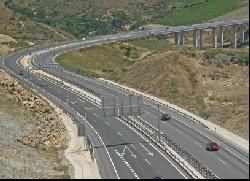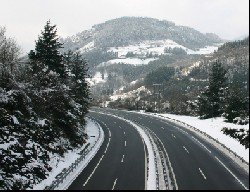|
Driving in Spain
Driving in Spain by car often provides visiting tourists with an unforgettable experience for many reasons, not least the fact that the country is in possession of endless kilometres of road which provides travellers with some truly stunning scenery, particularly on coastal or mountainous routes. Car users will often find that Spain’s road network is modern and extremely easy to use. In total, Spains road infrastructure clocks in at more than 310,000km, with more than 8000km of this consisting of motorways, and with ongoing plans to extend Spain’s motorway network continuously.

However, the continued improvement of Spanish roads comes at a price, one that is passed on to its users through seemingly expensive motorway tolls along main arterial routes. The cost of travelling on these roads is a big deterrent to regular users of Spanish roads, resulting in large traffic jams on adjoining routes caused by those who prefer not to pay to drive. If you are relatively inexperienced in using Spain’s road network however, it is advised you stick to the main routes, as secondary roads in small towns and in the countryside tend to be in poor condition due to lack of maintenance and should generally be avoided as a tourist. When driving in a town or city, it is important to have heightened awareness. Drivers have often called driving in major cities and towns in Spain “hell”, with it often commonplace for Spanish drivers to be more aggressive (especially when it is busy), with traffic jams common in peak season as well as inexperienced youngsters flying around on motorbikes and mopeds. In the past five years, Spanish authorities have done much to make the road network in Spain more navigable for both natives and tourists alike, demonstrated most in the road sign system. In the past, many towns were still signposted using old names not in use anymore which has now been changed, When driving in Spain a top tip for the routes into major cities is that their roads are preceded by corresponding letters to indicate the city you are heading to. Eg: M=Madrid, B=Barcelona, MA=Malaga etc. This is followed by the digits for the particular route you are using.

This signage is particularly useful to know if heading to one of the major cities when arriving at one of the entry points to the country such as the major airports of Alicante, Madrid, Malaga, Murcua, Barcelona, Jerez de la Frontera, Seville, Bilbao, Valencia, Viga etc or the ferry ports at Bilbao, Santander, Barcelona or Valencia where most visitors will usually arrange their car hire. The BasicsA quick guide to the basics of driving in Spain:
The UniqueAs over 90% of Spains road network is found on the mainland Peninsula people tend to forget that the Balearic and Canary Islands also have their own roads. However due to a combination of climatic conditions, regional government budgets and unique landscapes one can't just apply the mainland driving logic! For example Tenerife's roads have their own idiosincricies and one is advised to understand them before hiring a car on the island. As always, we provide a special guide to driving in Tenerife.
About Spanish motorwaysDriving in Spain presents a few peculiarities when considering motorways or highways. Not least due to the "peajes" or toll roads:
Spanish roads in generalThree very important points to consider for driving on standard Spanish roads:
Return from Driving in Spain to Travelling in Spain Unique Spain > Travelling in Spain > Driving in Spain |